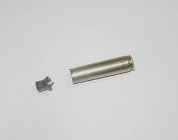>> My first question would be, how many time had
>> it been reloaded?
4 times. Full length resized after the first firing, then neck sized for the next three, this was the second full length resizing. And, if it matters, I seldom venture anywhere near max loads.
>> If this was a first or second reloading my next
>> question would be, What type of lubrication are you using.
Lyman spray lube.
>> My third question would be how do you clean
>> and prep your cases before sizing?
Tumbled in walnut, wiped clean, trimmed to length using a Wilson trimmer, case mouth chamfered using a RCBS chamfering tool, sprayed liberally with Lyman spray lube, rolled and sprayed again.
>> My fourth question is does your die have
>> any tool marks, corrosion, or trash in the
>> die walls?
Not that I could detect, other cases don't have any scratches or dents or orther signs of die problems.
>> If you are bumping the shoulder too hard you may be
>> crushing and/or expanding your case into the die wall.
>> After several loadings you have weakened the case to
>> the point of seperation.
A possibility, I'll have to more closely check the die setting in the future.
>> .223s usually pull the case head off when stuck
>> in a die.
I don't think it was stuck, though that's always possible. Since the first time I stuck a case in a die many years ago I always make sure they are clean and well lubed.
>> Case neck splits and splits at the web are more
>> common with the .223 than shoulder seperations.
Still, the question is, is there a way to have detected this before it happened? I know how to check the case body around the web for case thinning, but is there a way to check the upper part of the case?











